
 |
 |
 |
 |
 |
 |
 |
email: roadarch@outlook.com |
 |
| Orange Show |
(hit "refresh" to get the most recent version of this page; click on photos for larger images)
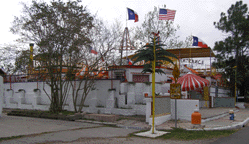 |
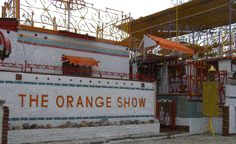 |
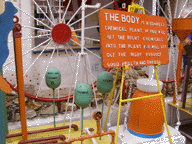 |
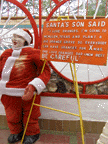 |
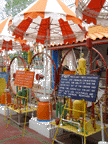 |
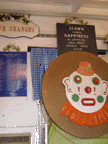 |
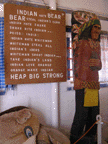 |
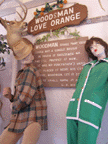 |
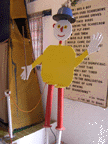 |
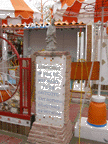 |
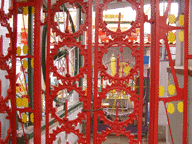 |
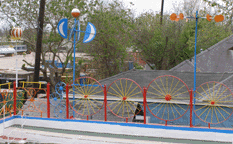 |
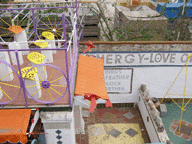 |
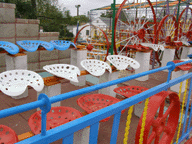 |
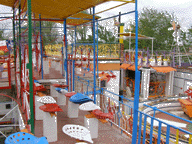 |
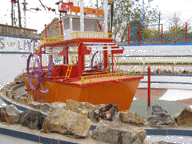 |
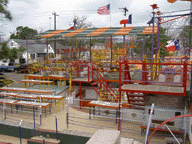 |
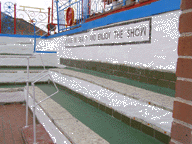 |
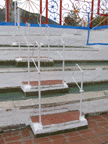 |
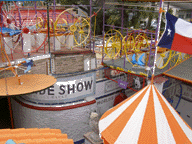 |
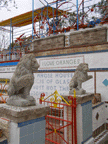 |
 |
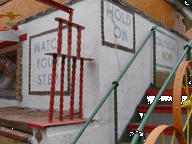 |
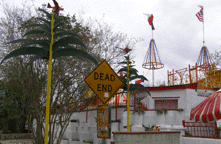 |
 |
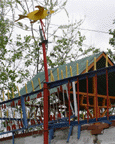 |
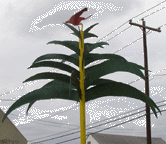 |
|
The Orange Show in Houston, TX is a multilevel structure of painted concrete, metal, tile mosaics, trash, spindly steeples, whirlagigs and birds with ragged iron wings and washers for eyes. It is a labyrinth of stairs, catwalks, and passageways with 2 amphitheaters, enclosed display areas, a guest shop, wishing well, fountains and 2 observation decks – all on 1/10th of an acre. It is a monument to the orange – a “work of genius” and the “ninth Wonder of the World” according to its creator.
Jeff McKissack had a degree in Commerce from Mercer University in GA and pursued graduate work at Columbia University in NY. He worked at a bank until he lost his job in the Depression. During this time, he delivered oranges from Florida to Atlanta and developed his passion for the fruit. In 1941, at the age of 40, he enlisted during WWII and learned to weld. After many years of drifting and odd jobs, he settled in Houston and became a mail carrier at the age of 50. He built his own home and then in the early 1950s he bought 2 lots across the street. Originally, he intended to start a worm farm but then decided on a plant nursery instead. He propagated his own plants and did well. But then one day he announced he was going out of business and gave away all the plants. He decided to build a beauty salon, figuring it would give him the chance to meet lots of women. McKissack never married or had kids. But those plans fell through in 1956, when he decided beauty salons were going out of style and he got the idea for the Orange Show. He believed every event in his life pointed him in the direction of building his creation. The small scale theme park was to be devoted to the “perfect food”. He believed oranges were a pure form of energy and the source of all that is good and healthy.” Starting in 1962 and for more than 25 years, he collected and built with bricks, railings, tractor seats and iron wheels. As he made his rounds as a mail carrier, he was always looking for more materials. He came home every day with the car loaded down with the stuff. When he retired in 1959, he worked on the project round the clock. There were no architectural plans – he just built as he went. In 1960, he privately published “How You Can Live 100 Years and Still be Spry”. He created what he thought was "the most beautiful show on earth, the most colorful show on earth, the most unique show on earth." He built it entirely himself rejecting neighbors’ offers of help. He’d go every year to Hot Springs, Arkansas to bathe in the spring water with healing properties and on the way back he’d stop at every antique store and bought stuff to add to the Show. He envisioned that 80-90% of America would come visit his place. He built an amphitheater and museum in anticipation of the crowds. The Show was painted in bright primary colors, festooned with awnings, U.S. and Texas flags, banners and signs. Tiled messages embedded in the stucco walls include: “Eat Oranges and Live”; “Oranges for Energy”, “Love Me, Orange, Please Love Me”. There were also stock aphorisms such as “Birds of a feather flock together”. Although McKissack believed the Orange Show was “as new as the moon and the biggest thing to hit Houston since the Astrodome”, on opening day in 1979, only about 150 people came. It was a big letdown to be done building and then have low attendance. He started spending lots of time in his house across the street and only 7 months after opening the Orange Show, he collapsed and soon died at the age of 78. In 1981, 22 friends and supporters bought the place from McKissak’s heir, restored it and created the Orange Show Foundation to ensure his creation would live on. The Foundation has become a Houston institution sponsoring pageants, festivals, tours, music and art events. The Orange Show reopened in 1982 and has become a popular tourist destination after all – and folks can buy fresh squeezed orange while visiting. |
| Special Places Main Page |
| RoadsideArchitecture.com |
Copyright. All photos at this website are copyrighted and may only be used with my consent. This includes posting them at Facebook, Pinterest, blogs, other websites, personal use, etc. Tips & Updates. If you have suggestions about places that I haven't covered, historical info, or updates about places/things that have been remodeled or removed, I'd love to hear from you: roadarch@outlook.com. |